Welcome to the second edition of Unsung Heroes, where I delve into the archives to find some of the best individual performances in Ohio State football history.
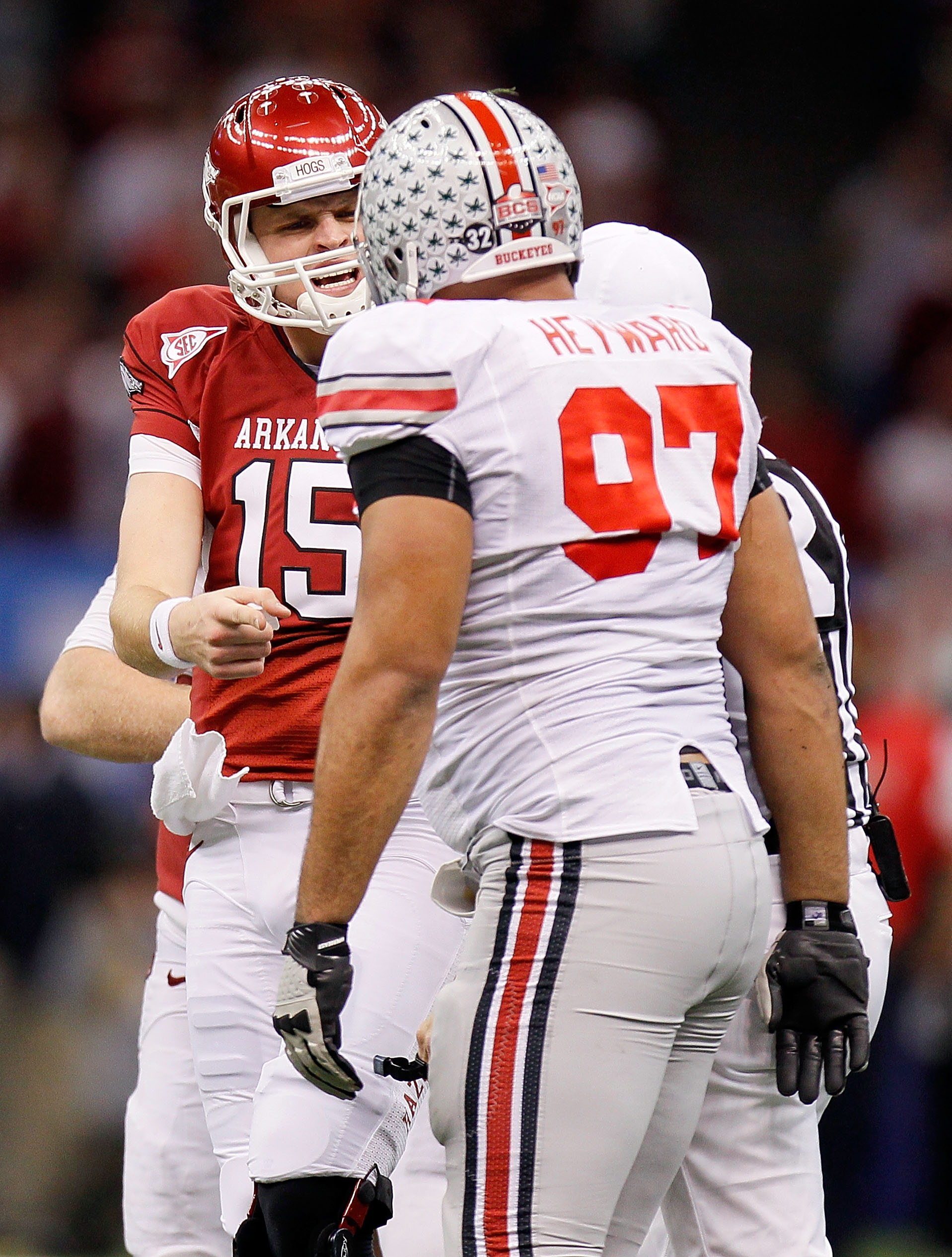
I like to imagine the NCAA trying to portray themselves as Big Brother from Orwell’s 1984. “Bagmen are charitable. Tattoos are violations.”
In addition, I like to think media outlets like CBS and ESPN collectively go to church every Sunday to hear the sermon of the likes of Steve Spurrier, Phil Fulmer, and Nick Saban; while hailing and bowing before a monument of Bear Bryant, praising his contributions to God’s favorite football conference.
The joke’s on them. No matter how hard the NCAA tries, I still have memories from this game. I don’t care if they throw me into the loony bin for proclaiming that I heard the voices of Brad Nessler and Todd Blackledge spend over three hours calling a game on the evening of January 4th, 2011; a game where Ohio State defeated an SEC team in the Sugar Bowl that wasn’t coached by Nick Saban and led by OSU’s third string quarterback. I will not be deceived!
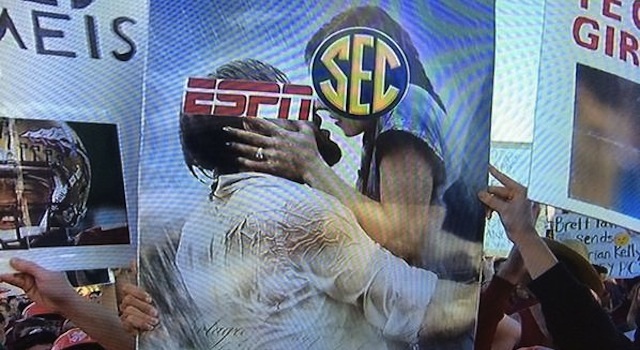
A lot of things can change in a decade, and football is of no exception. Ten years ago, Saban had won only one title at Alabama, and the 2010 Crimson Tide lost three games that season despite having nine starters that would eventually become first round picks. Rich Rodriguez was still the head coach at Michigan. Joe Pa was still at Penn State and the university’s reputation wasn’t completely tarnished. D’Antonio won on a fake field goal against Notre Dame, and suffered a heart attack a few hours later. The WAC still existed, and Boise State was feasting on opponents, threatening to play in the national title; as was TCU, who was still in the Mountain West being led by the Red Rifle.
For Arkansas and Ohio State, these two teams appear almost unrecognizable to their current state of the programs. Ohio State was being led by The Senator, the sweater vest was a weekly sight to see. Terrelle Pryor was the quarterback. Boom Herron was the leading rusher. DeVier Posey and Dane Sanzenbacher were the two leading receivers. And Tressel-ball was still in vogue.
In 2010, Arkansas wasn’t losing to the North Texas and San Jose State’s of the football world. One could argue this was among the best squads Arkansas had ever assembled. They beat Georgia in Athens. They beat LSU in the final game of the regular season. They scored 43 on the eventual national champion Auburn Tigers in defeat. Hell, they held a late fourth quarter lead against Alabama before two backbreaking Ryan Mallett interceptions doomed them.
The Sugar Bowl was fascinating for a multitude of reasons. The vaunted Arkansas passing game averaged close to 334 yards per game against the stout Silver Bullet defense allowing only 165 yards per game through the air. This was the first time Jim Tressel, the personification of class, coached against—well…not the most respected guy in the world—in Bobby Petrino. More than a contrast in styles, this was about pride. Ohio State was 0-8 in bowl games versus SEC teams. They would have a chance to end that hideous streak.

In order to come out of New Orleans with a victory, the key to stopping Arkansas’s offense was to negate their passing attack. Arkansas had four wide receivers (Greg Childs, Jarius Wright, Joe Adams, and Cobi Hamilton), plus their starting tight end (D.J. Williams), that would eventually play in the NFL. Relying solely on coverage wouldn’t work. In order for Jim Heacock and Luke Fickell to execute their game plan, they would need to pressure Ryan Mallett and make him uncomfortable in the pocket. It all started and ended with #97 Cameron Heyward.
Heyward is one of the abundance of reasons I hate when people only judge players based off stat sheets. When you look at Heyward’s stats from the Sugar Bowl—hell, when you look at Heyward’s stats for the entire 2010 season—you would think he had a decent showing, but nothing extraordinary.
Heyward had an impressive junior season in 2009, racking six and a half sacks. Many expected him to declare for the NFL draft following the 26-17 Rose Bowl victory over Oregon, but he decided to return for his senior season. Most of the “experts” would’ve called this a foolish mistake on his part, and pointed to his stat sheet as proof. Going into the Sugar Bowl, Heyward only had two and a half sacks, tying him with Brian Rolle for fourth on the team behind Nathan Williams, Dexter Larimore, and John Simon. He did have one glorious interception in week 2 against Miami (which you can watch right here).
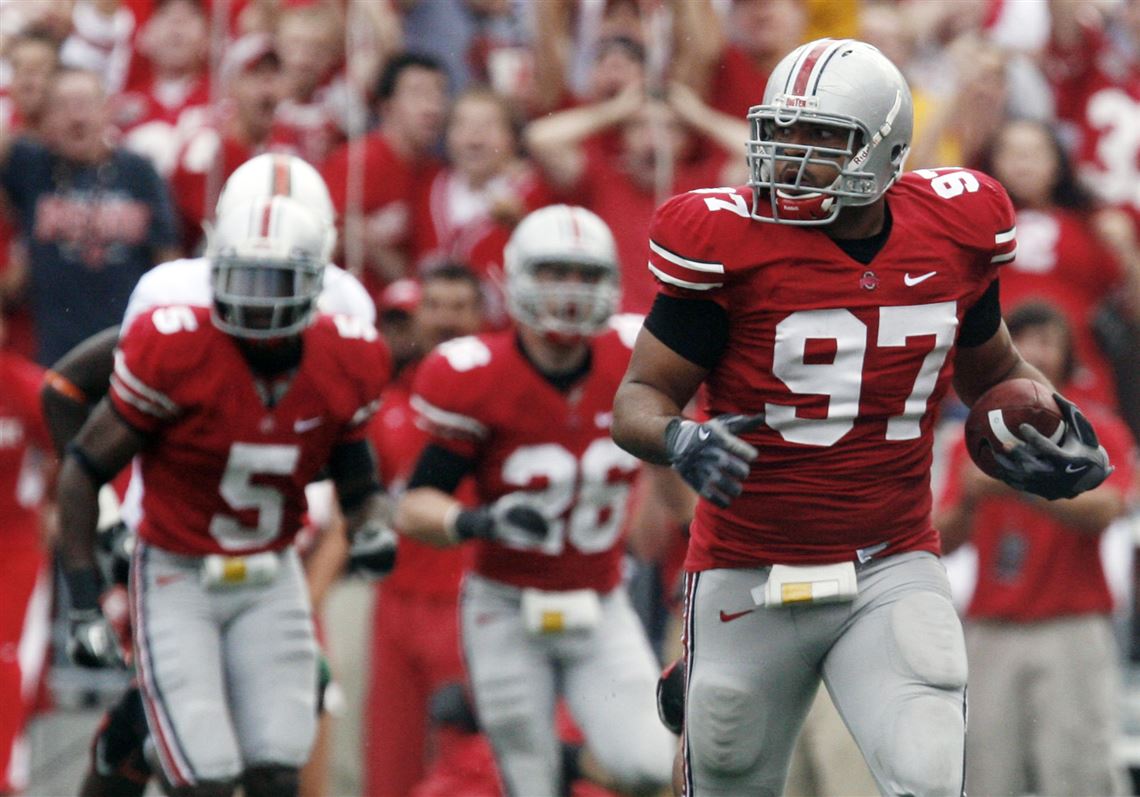
A statistician would look at Heyward and claim he would be a non-factor. Fortunately, football is played with top-notch athletes and not number nerds.
It was evident from the first play from scrimmage that the Silver bullets keyed in on applying pressure to Mallett. Arkansas’s first play was an empty, five-receiver look. Mallett, not exactly known for being swift-footed (as proven by his 5.37 40 time), was forced to double clutch, scramble forward to avoid a sack, and threw an incompletion.
On the third play, OSU rushed only three, meaning Heyward was double-teamed by Arkansas’s left tackle and left guard. It hardly mattered. Heyward grabbed hold of the back of Mallett’s jersey and forced a hurried throw that one-hopped into an incompletion. Heyward didn’t get a sack, but his penetration through a double team forced a three-and-out by the Razorbacks. The Buckeyes turned that into an opening drive touchdown, thanks to Dane Sanzenbacher’s epic fumble recovery in the end zone off a Pryor fumble.
Arkansas trailed 14-7 early into the second quarter. They were able to drive down to the OSU 31, being met with a 4th and 1. They lined up in a double tight end offset-I formation, normally a power running alignment. But instead, Mallett dropped back to pass, and with a clean pocket, located his tight end D.J. Williams running a 10-yard in route, having gotten past Orhian Johnson in man coverage. He cocked his arm back to let it rip, but the pass was knocked down at the line of scrimmage by Heyward, who was being held by Arkansas left tackle DeMarcus Love, otherwise he may have registered a sack on the play.
The Buckeyes took over and went on an ensuing 69 (nice)-yard drive that ended in a Pryor 15-yard touchdown pass to Sanzenbacher to extend the lead to 21-7. Two of the three scores thus far were due in large part to Heyward making a play on either third or fourth down.
On Arkansas’s following drive, they had a 2nd and 1 on their own 49. Arkansas running back Knile Davis ran a stretch play to the left, where Heyward lined up. Big mistake. Immediately off the snap, Heyward avoided a cut block from D.J. Williams, surged past the tackle and guard assigned to him, and tackled Davis for a three-yard loss. A three-yard loss might not sound like much, but it backed Arkansas up into 3rd and 4, a passing situation that they unsuccessfully tried to convert. Another Arkansas punt, though the OSU offense didn’t score next possession.
Heyward sustained a left elbow injury the following drive after another tackle for loss on 1st down, and nearly sacking Mallett while being double-teamed on a three man rush, but was beaten to the punch by Dexter Larimore. On his first play back, now donning an elbow brace, Heyward lined up at left end, ran an inside stunt, and nearly drove Arkansas center Travis Swanson, a man who would start in the NFL for five seasons, back into Mallett for a sack. But Mallett was able to throw the pass to his check down before hitting the turf.
Four years before Joey Bosa immortalized Penn State running back Akeel Lynch as an instrument of destruction against Lynch’s own quarterback; Cameron Heyward nearly did the same—on his first play back from injury against a 312-pound lineman.
I understand I’m going pretty long with this one, but having watched the game over again, I’m mesmerized by Heyward’s play. I’ll go ahead with a quicker rundown for the rest of the game. Heyward wound up being double or triple teamed for all but two of Arkansas’s drop-back pass plays from the second quarter onward. There was a situation where Heyward was tripled teamed and had one of the Arkansas guards lying on him well after the play ended to try and slow him down. But all it did was piss him off. Arkansas held him for most of the game, but were only called once on a toss play with less than six minutes left in the 4th.
Despite all of that, I tallied nine separate times he affected a throw by generating enough pressure on Mallett. Arkansas attempted 47 passes that night, meaning that Heyward forced Mallett to either misfire or throw the ball away once nearly every five times he dropped back to throw. His second sack of the game came when he comically tossed DeMarcus Love to his knees and combined with Dexter Larimore for the credited sack.

For as much as I’m gushing over Heyward, you would think Ohio State would be up big in this game. They were, in the 2nd quarter. Ohio State’s offense had marched at will in the first half, going up 28-7 before Arkansas kicked a field goal on the final play before halftime. Afterwards, Ohio State only scored three points, thereby letting Arkansas to slowly climb back.
The two teams exchanged field goals in the third, Arkansas scored a touchdown and successfully attempted a two-point conversion to make it 31-21. Arkansas was awarded a safety despite Boom Herron’s forward progress being stopped three yards before being driven back into his own end zone to make it 31-23, and Arkansas’s ensuing possession led them to kicking a field goal, making it 31-26. In a very un-Tressel-like move, he decided to gamble and go for a 4th and inches on his own 38 with 6 minutes remaining. Boom Herron appeared to have gotten it by diving over the pile, but was stripped of the ball mid-flight. Ohio State recovered the ball, but behind the first down marker, turning the ball over on downs.
Arkansas was now less than forty yards from taking the lead for the first time. But on their first play of the drive, they were called for holding—holding none other than Cam Heyward. They backed up to 1st and 20. The following three plays were an incompletion, a four-yard pass, and a drop. They were forced to punt. This drive is widely forgotten in the grand scheme of the game, but Heyward drawing a holding penalty killed the drive before it began.
The Buckeyes weren’t out of the woods yet, however. They were able to run the clock down to 1:15 before having to punt. The punt is a Tressel specialty, the most important play in football, as he called it. What could possibly go wrong?
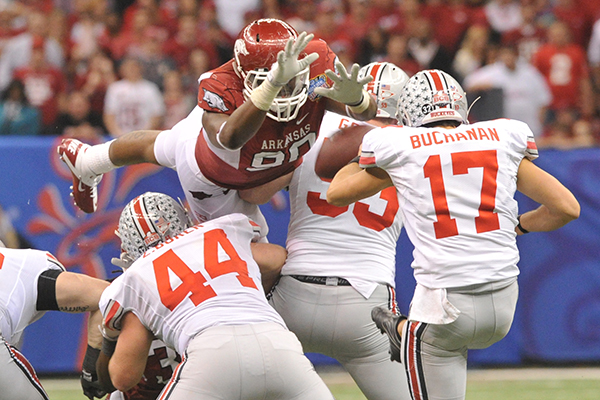
Arkansas’s Chris Gragg leapt over the three-man shield to block Ben Buchanan’s punt. The ball was rolling behind every Buckeye on the field. Arkansas true freshman receiver Julian Horton had nothing but green artificial grass ahead of him. Had he gone for a scoop-and-score, nobody would’ve tackled him. But instead, the ball slipped through his hands while he was standing, and he instinctively dove on the ball, recovering it at the OSU 18-yard line.
I’m sure most of you were hurling your remotes across your living room, cursing at your TV screens. It’s all right, you can admit it. I was doing the same thing. How could this happen? How could they blow this? But, there was still a game to be played.
1st and 10, Mallett fired a ball to his tight end D.J. Williams, who dropped it at the 10-yard line, setting up 2nd down. On 2nd and 10, Mallett dropped back, trying to rifle a curl to Jarius Wright, but stepping in front of the throw was Solomon Thomas, a defensive end that dropped into coverage.
On the play, both Thomas and Heyward dropped into coverage from their D-end positions in a play that was eerily similar to Steve Miller’s pick six against Alabama four years later. Apparently SEC teams just love throwing interceptions to OSU D-linemen in the Sugar Bowl. Heyward was lined-up in front of the left guard, Alvin Bailey. Bailey’s focus is on Heyward and only Heyward. When Heyward dropped back into coverage, Bailey was too slow in blocking Ross Homan blitzing from his linebacker position. Homan goes through untouched, hitting Mallett as he releases the fate-sealing dagger of an interception. How fitting for Mallett, a guy who originally played for Michigan, to have his last collegiate pass lands in the arms of a Buckeye.
Heyward’s presence alone was enough to seal the game. He didn’t rush the passer, he didn’t even contest the throw despite dropping into zone coverage. But he affected the outcome of the play more than anyone else by doing less than anyone else.
Remember earlier when I said I hate when people judge players solely by their stats? Add Solomon Thomas to that list of reasons. A defensive end who entered the game with only nine tackles and zero sacks on the season, yet was one of the five players to be involved in the infamous “Tat-gate” debacle. Who cared if he got suspended? What about Pryor, Herron, Posey, and Mike Adams, the true stars of the team. And yet, it was Thomas that dropped back into coverage with the only Buckeye D-lineman to record an interception hitherto, and he decided to one-up Heyward by making a game-sealing pick.
Tressel-ball till the very end, baby!
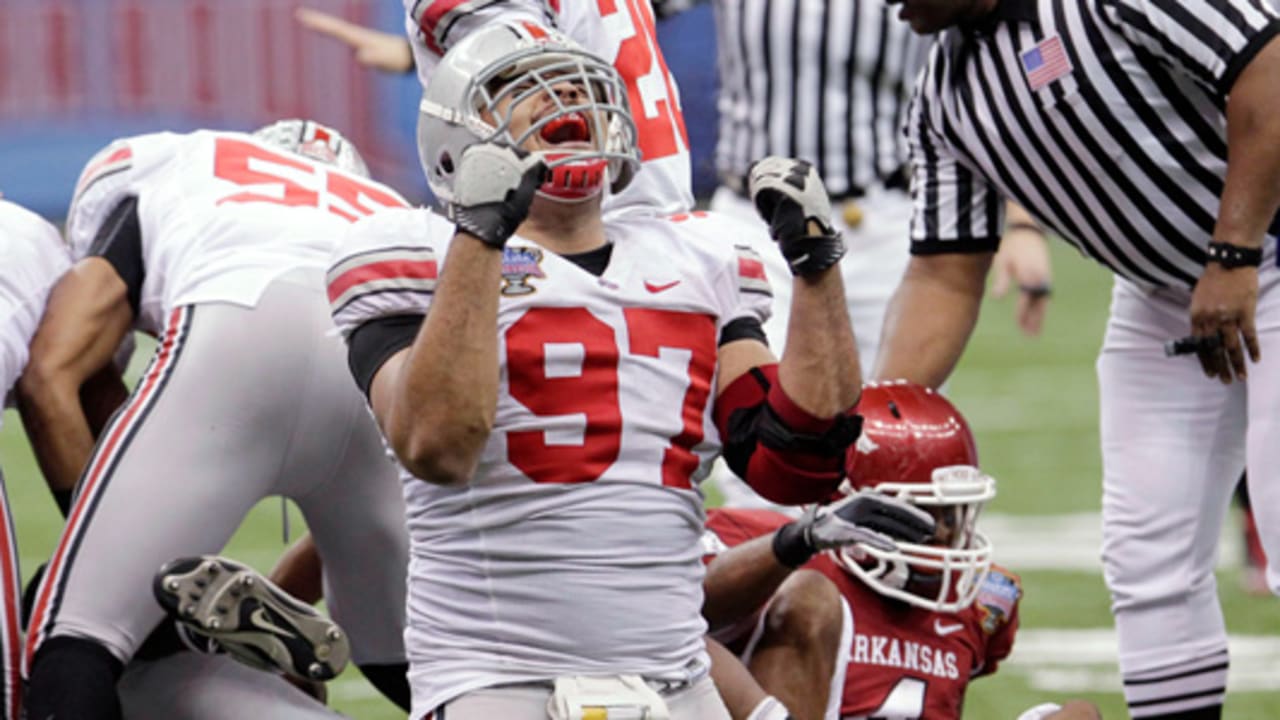
ESPN’s Holly Rowe interviewed Jim Tressel after the game, asking how he could describe Heyward’s performance. Tressel’s words: “Cameron Heyward is a special person first, and a great football player second. But, um, this was a special night for him—to come down where he’s from, his dad played here with the Saints, and, uh, he’ll remember this one for the rest of his life.”
I choose to see this as the gridiron’s odd display of poetry. Two big men, whose job is to primarily sack the quarterback, each having signature interceptions that range on completely different ends of the emotional factor. Heyward’s week 2 red zone interception and subsequent eighty yard return is both hilarious and hypnotic. To see a three hundred pound man run that far with a football in his hands is legendary if not comedic. And then there’s Solomon Thomas making an interception that brought euphoria for several reasons. Ohio State won a thrilling game that they appeared to be handing to Arkansas. They finally beat an SEC team in a bowl game, in their backyard no less. And it brought a ray of light through the hanging overcast of the joke of a scandal that cost Tressel his job, Pryor his OSU career, and the 2012 team a national title.
It’s a bizarre, yet beautiful way for Heyward’s Ohio State playing career to end. A fearsome pass rusher that had the size to lineup inside at tackle, but also the athleticism to lineup at end; and his last collegiate play involved him dropping into coverage.
And no matter how much the NCAA tries to convince the masses that this game, and this entire season, was vacated, my memory of this game, of a man playing his heart out to vanquish the stigma that Ohio State couldn’t hang with the all mighty SEC, will never be erased. Like Tressel said, Heyward will remember this one for the rest of his life. As will I, Coach, as will I.


Thank you for reading.
Video Links (YouTube's sharing feature isn't working for me):
Cameron Heyward vs. Arkansas
Ohio State vs. Arkansas (entire game)
Previous Unsung Heroes forum links:
(#1) Chris Gamble's Heroic Performance in the 2002 National Championship
